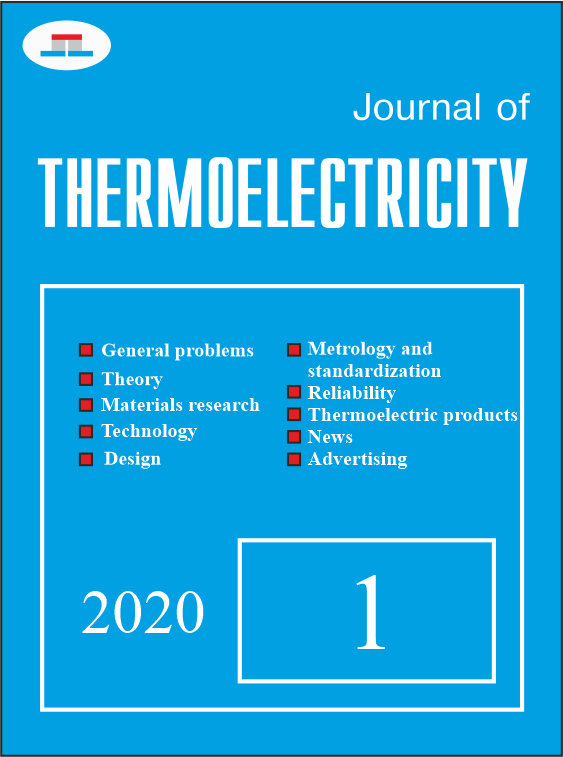Generalized theory of thermoelectric energy conversion for permeable thermoelements
DOI:
https://doi.org/10.63527/1607-8829-2020-1-50-60Keywords:
generalized theory of permeable thermoelements, methods of designing a permeable thermoelementAbstract
A generalized theory of calculation of permeable thermoelements is presented, taking into account the dependences of the parameters of legs material on the temperature and current carrier concentration and changes in the conditions of heat transfer along the height of the leg. Methods for simulating the distributions of temperatures and heat flows in 1-D and 3-D dimensional models of a permeable thermoelement are described. The theory of calculating permeable thermoelements has been improved for the case of solving a multifactor optimization problem in order to achieve the maximum energy efficiency of thermoelectric energy conversion. Bibl. 12, Fig. 2.
References
V.N. Kozliuk, G.M. Shchegolev (1973). Termodinamicheskii analiz pronitsayemykh termoelektricheskikh kholodilnikov [Thermodynamic analysis of permeable thermoelectric coolers]. Teplofizika i teploteknika, 25, 96-100 [in Russian].
G.K. Kotyrlo, V.N. Kozliuk, Lobunets Yu.N. (1975). Termoelektricheskii generator s razvitoi poverkhnostiu teploobmena [Thermoelectric generator with a developed surface of heat exchange]. Teplotekhnicheskiie problemy priamogo preobrazovaniia energii, 7, 85-95 [in Russian].
Yu.N. Lobunets (1989). Metody rascheta i proektirovaniia termoelekricheskikh preobrazovatelei energii [Methods for calculation and design of thermoelectric power converters]. Kyiv: Naukova dumka [in Russian].
Y.J. Cui, B.L. Wanga, K.F. Wang, L. Zheng (2019). Power output evaluation of a porous annular thermoelectric generator for waste heat harvesting. International Journal of Heat and Mass Transfer, 137, 979–989.
E.S. Reddy, J.G. Noudem, C. Goupil (2007). Open porous foam oxide thermoelectric elements for hot gases and liquid environments. Energy Convers. Manage., 48, 1251–1254 .
Y.J. Cui, B.L. Wang, K.F. Wang., et al. (2018). Fracture mechanics analysis of delamination buckling of a porous ceramic foam coating from elastic substrates. Ceram. Int. 44, 17986–17991.
I.M. Kadenko, O.M. Kharitonov, R.V. Yermolemko (2010). Osnovy teplohydrauliky yadernykh enerhetychnykh ustanovok [Fundamentals of heat hydraulics of nuclear power plants]. Kyiv: “Kyiv University” Publishing Centre [in Ukrainian].
R.G. Cherkez, P.P. Fenyak, D.D. Demyanyuk (2013). Computer simulation of permeable cooling thermoelement. J.Thermoelectricity, 5, 64-74.
L.I. Anatychuk, R.G. Cherkez (2003). On the properties of permeable thermoelements. Proc. of XXII Intern. Conf. on Thermoelectrics (France), 480-483.
L.I. Anatychuk, L.N. Vikhor (2002). Computer design of cascade modules for generators. J.Thermoelectricity, 4, 19-27.
R.G. Cherkez (2013). Energy characteristics of permeable thermoelements. Journal of Electronic Materials, 42(7), 1558-1563.
L.S. Pontryagin, V.G. Boltyanskii, R.V. Gamkrelidze, E.F. Mishchenko (1976). Matematicheskaia teoriia optimalnykh processov [Mathematical theory of optimal processes]. Moscow: Nauka [in Russian].




